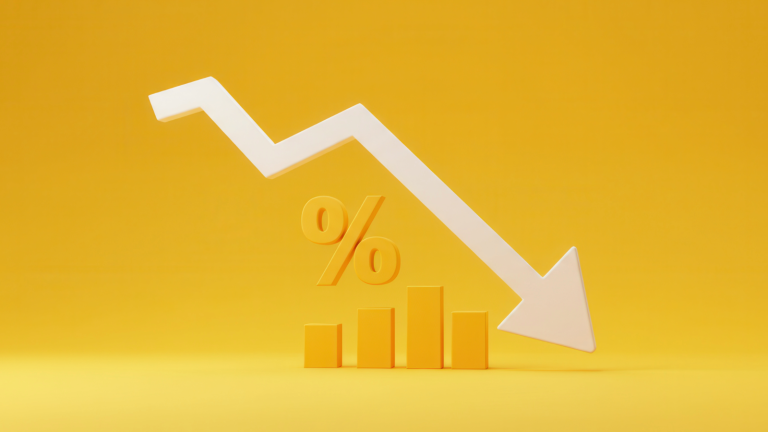“Liberation Day” was a mess… The new levies that U.S. President Trump announced were far more aggressive than anyone had expected. A 10% minimum universal tariff and country-specific tariffs north of 50%? It was a full-scale shock to the global trading system.
Investors have been panicking ever since, selling hand over fist in an attempt to mitigate risk. As a result, the Dow Jones slid over 3%. The Nasdaq Composite took a 4%-plus nosedive. And the S&P 500 sank more than 4% as well, now on track for its worst week since 2020’s COVID crash.

Not to mention, China declared that it would impose additional 34% tariffs on the U.S. to match those that Trump announced yesterday. This move is stoking fears that our nation’s trading partners will retaliate instead of negotiate, exacerbating the ongoing trade war.
And yet, buried underneath all the chaos… there’s a silver lining forming: one that could reshape the economy in a very big and very bullish way…
The 10-year U.S. Treasury yield’s collapse.
It’s not just a footnote in this story. It might actually be the main event.
Let’s start with the numbers.
Tariff Fears Are Pushing the 10-Year Lower
Earlier this year, the 10-year Treasury yield was pushing 4.8%, a level that was putting real pressure on the economy. That’s because the 10-year largely influences mortgage rates, business borrowing, consumer lending, and more.
But since the trade war rhetoric escalated in March – and especially after the “Liberation Day” announcement – that yield has collapsed.
Indeed, just before Trump’s tariff announcement, the 10-year was hovering around 4.25%. By that evening, it dropped to 4.07%. And as of this writing, we’re sitting at about 3.93%.
That’s an 80-plus-basis-point drop from recent highs. In bond market terms, that’s not a gentle breeze; that’s a hurricane-force tailwind for the economy.
And I’d venture to say that this is no accident. It’s policy by design.
That is, in recent weeks, both President Trump and Treasury Secretary Scott Bessent have made it clear that their economic focus isn’t on the stock market – it’s on the bond market – and specifically, the 10-year yield.
As Bessent said in a recent interview, “We’re watching the 10-year, not the Dow.”
Translation: This administration’s goal isn’t to juice the S&P 500 with feel-good headlines. Seemingly, it’s to strategically depress long-term interest rates, which influence everything from mortgages to auto loans to small business credit lines.
The Long-Term Gains
From what we can tell, the Trump Administration is trying to stimulate Main Street. And they’re using bond market psychology to do it, with a particular focus on the 10-year yield.
That makes sense because it is hard to overstate how influential the 10-year is for our financial ecosystem. It’s the anchor rate for an entire constellation of borrowing avenues: mortgages, corporate bonds, auto and student loans, municipal bonds, personal and small business loans…
When the 10-year drops, everything else drops with it.
And with yields down more than 80 basis points in the past couple of months, we’re already starting to see borrowing costs decline across the board. For example, mortgage rates are dipping back toward 6.5% after threatening 8% just a few months ago.
That’s huge. Lower borrowing costs means that more buyers can afford more houses. Businesses can refinance at lower costs. Consumers have more flexibility with credit. Municipalities can invest in infrastructure more affordably.
In short? Lower rates mean more activity. More activity means more jobs, more spending, and – eventually – more growth.
Tariffs: No Risk, No Reward?
Now, is this a risky strategy? Absolutely.
You don’t slam global trade partners with 50% tariffs and expect everything to go smoothly. You don’t deliberately trigger a market panic and hope it resolves itself peacefully in a few weeks.
But as any seasoned investor knows: where there’s no risk, there’s no reward.
This administration is playing chess, not checkers, meaning this latest tariff announcement was the opening move – not the endgame.
The real apparent goal is to force the world to the table, restore trade balance, and reignite economic growth at home, all while keeping inflation in check through lower long-term yields.
If this plan works, it could represent a masterstroke of economic engineering: short-term pain in exchange for long-term gain.
So far, it’s working.
Yes, stocks are down – brutally so, in fact. But the real economy is still hanging in there.
- Unemployment remains near historic lows at 4.1%
- Consumer spending continues to hold up
- Retail sales are positive year-over-year (3.36% as of February ‘25)
- Business investment hasn’t collapsed
And now, with the 10-year yield breaking down, all those macro pillars could get a second wind. Lower rates mean more affordability, more financing, and more risk-taking.
This is the exact stimulus-through-rates tariff strategy the White House was gunning for. And it seems to be taking root.
Right now, investors are fixated on the tariff headlines – and understandably so.
But in the process, they’re ignoring what might be the most important macro development of 2025 so far: a sustained collapse in long-term interest rates deliberately engineered by policy makers with the express goal of restimulating economic activity.
The Final Word on the Tariff Chaos
If the trade chaos is resolved in the next few weeks, as we expect, lower rates will remain in place, but the uncertainty premium will evaporate.
And when that happens? Stocks will likely explode higher, powered by the twin forces of reaccelerating growth and cheap capital.
This is the same playbook that ignited the 2009-2012 and 2020-’21 rallies.
Of course, we’re not naïve. We know the risks are real. A full-scale trade war would be a recessionary blow. But our base case hasn’t changed:
- These tariffs are negotiation tools, not permanent policy
- The next two weeks will likely bring deals, not doom
- And as those deals come together, the downside risk gets repriced rapidly
Meanwhile, the 10-year has already done its job. Its decline has triggered lower rates and planted the seeds for the next economic upswing.
Markets haven’t caught on yet.
And AI 2.0 stocks might represent the biggest opportunity of all here…
Not just any old AI play – but the building blocks for the Robotics Revolution. Elon Musk, the world’s richest man, is certainly all-in.
Tesla (TSLA) is already using its Optimus robots to complete a variety of tasks in its factories. It plans to ramp up production to use them in its factories worldwide. It’s said that next year, it will start selling its bots to outside companies. And after that, it aims to offer them to consumers like you and me.
In fact, on a recent Wall Street conference call, Musk said that he thinks “Optimus will be overwhelmingly the value of the company” with “the potential to be north of $10 trillion in revenue.”
We think this is the next wave of growth in the AI Boom. But Tesla stock isn’t the best way to play it…
Learn all about the supplier that could benefit most as AI 2.0 flourishes.
P.S. According to my InvestorPlace colleague Louis Navellier, what we are witnessing is a profound transformation of the way we do business. The goals of the tariffs have always been the same: level the playing field on trade, increase tax revenue, and ultimately create a massive wave of onshoring to the United States.
Once the dust settles and the market realizes the effects of this mega-wave of onshoring, the U.S. economy could be primed to boom.
To explain what investors can expect from the tariffs – and how they can profit – Louis sat down with Luis Hernandez, Editor-in-Chief of InvestorPlace, for an in-depth discussion on the latest policy developments.
Check out that video now to learn how to navigate the markets post-Liberation Day.

